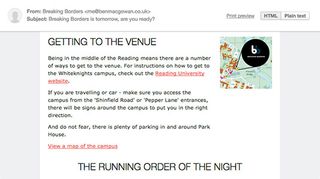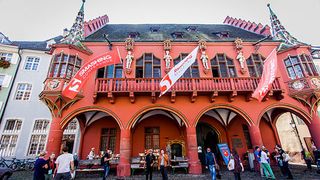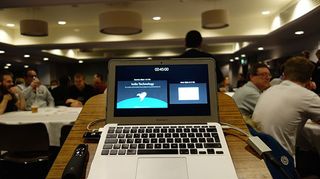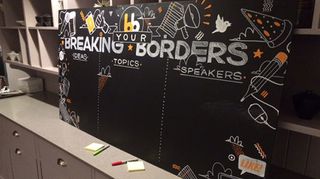How to create a community at your event
Design events aren't lectures, they're about creating a community – here's some tips to achieving this.
At a time when conferences and events within the web industry are under constant scrutiny, it is hard as an organiser not to have an opinion, look at your own event and evaluate its aspects.
Our sole responsibility as event organisers is to create a safe environment for a community to grow.
Now, I may have been watching too much of Olivia Pope from Scandal and come across strong with that statement, but it's the truth.
Regardless of our audience, its size, location, the event subject or the reason we got into organising events in the first place, we have that responsibility. For everyone; our audience members, crew and speakers.
These are some of the reasons why I have teamed up with fellow event organiser, Cat Clark, to organise ConfConf: a conference aimed at enabling people to improve their events and challenge industry perspectives.
Communication

From the moment people first engage with you and your event to after they leave, there should be a consistent approach to communication and tone, preferably one that makes you approachable.
Give everyone the information they need upfront and reiterate to them at key points in the lead up to the event. Don't make people go searching for it.
Get the Creative Bloq Newsletter
Daily design news, reviews, how-tos and more, as picked by the editors.
Also think about what information your audience and speakers might want that you wouldn't necessarily think of – this can make a big difference to whether they decide to partake. I often refer back to this fantastic post written by Relly Annet-Baker back in 2012, Conference organisers: a point for your consideration.
Venue

It's hard finding a venue for your event which ticks all the boxes, but there are a number of key factors that need to be taken into consideration.
Location, location, location. Is your venue easy for people to access? Does it give attendees and speakers a good number of options for transport? Take into consideration also the times that your event will be taking place. If your event runs later into the evening will those forms of transport become more limited? Would people attending on their own feel safe?
You will be surprised by how important privacy is to people and want to be saved from perceived judgement. So is your event held within a private area and of the venue? People can often feel nervous and exposed if your event is simply run in the corner of a bar or restaurant.
Which brings me on to my next point. Thinking about the intentions of your event and wider audience, is your venue creating a barrier of entry for people to attend? Our industry is one of the best at nurturing talent and sharing knowledge with a large portion of the audience being young students with a thirst for knowledge. Your venue may be preventing them from doing that, as pointed out by Benjamin Hollway in his article Sorry, you're not old enough.
Content

Everything hangs around the content of your event. So you need to think about whether the content that you are creating a platform for is appropriate for your audience.
Many speakers will have a similar talk that they do at a number of different conferences, it may be a brand new talk for them, but feel free to raise the sensitivities which may be required for your event. This could be as small as refraining from swearing, but this could have a lasting impression on your audience members.
You are the curator of the event. Therefore you need to make sure that the content is of good quality, is what your audience want to hear and there is no contradiction between talks to confuse matters.
Feedback mechanism

After all of that, it is important to give everyone the equal opportunity to give their feedback.
Having got your communication locked down everybody knows that you are approachable, but make sure that you respond and listen to what they have to say. Make visible changes so people can see their feedback coming into fruition.
At Breaking Borders, I recently introduced an illustrated chalkboard for attendees to submit their ideas, topic and speaker suggestions. Giving me as an organiser valuable insight into what they want out of the event.
Creating these opportunities for feedback and input creates a community who feel that the event is as much theirs as it is yours.
Words: Ben MacGowan
Ben MacGowan is UI evangelist for Creative Jar. He is also co-founder and organiser of Breaking Borders and ConfConf.
Like this? Read these!
- How to create a pop-up shop: 7 expert tips
- Useful and inspiring flyer templates
- Create a perfect mood board with these pro tips and tools

Thank you for reading 5 articles this month* Join now for unlimited access
Enjoy your first month for just £1 / $1 / €1
*Read 5 free articles per month without a subscription

Join now for unlimited access
Try first month for just £1 / $1 / €1
The Creative Bloq team is made up of a group of design fans, and has changed and evolved since Creative Bloq began back in 2012. The current website team consists of eight full-time members of staff: Editor Georgia Coggan, Deputy Editor Rosie Hilder, Ecommerce Editor Beren Neale, Senior News Editor Daniel Piper, Editor, Digital Art and 3D Ian Dean, Tech Reviews Editor Erlingur Einarsson and Ecommerce Writer Beth Nicholls and Staff Writer Natalie Fear, as well as a roster of freelancers from around the world. The 3D World and ImagineFX magazine teams also pitch in, ensuring that content from 3D World and ImagineFX is represented on Creative Bloq.
